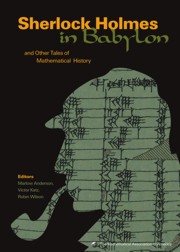Book contents
- Frontmatter
- Introduction
- Contents
- Ancient Mathematics
- Medieval and Renaissance Mathematics
- Foreword
- The Discovery of the Series Formula for π by Leibniz, Gregory and Nilakantha
- Ideas of Calculus in Islam and India
- Was Calculus Invented in India?
- An Early Iterative Method for the Determination of sin 1°
- Leonardo of Pisa and his Liber Quadratorum
- The Algorists vs. the Abacists: An Ancient Controversy on the Use of Calculators
- Sidelights on the Cardan-Tartaglia Controversy
- Reading Bombelli's χ-purgated Algebra
- The First Work on Mathematics Printed in the New World
- Afterword
- The Seventeenth Century
- The Eighteenth Century
- Index
- About the Editors
Sidelights on the Cardan-Tartaglia Controversy
from Medieval and Renaissance Mathematics
- Frontmatter
- Introduction
- Contents
- Ancient Mathematics
- Medieval and Renaissance Mathematics
- Foreword
- The Discovery of the Series Formula for π by Leibniz, Gregory and Nilakantha
- Ideas of Calculus in Islam and India
- Was Calculus Invented in India?
- An Early Iterative Method for the Determination of sin 1°
- Leonardo of Pisa and his Liber Quadratorum
- The Algorists vs. the Abacists: An Ancient Controversy on the Use of Calculators
- Sidelights on the Cardan-Tartaglia Controversy
- Reading Bombelli's χ-purgated Algebra
- The First Work on Mathematics Printed in the New World
- Afterword
- The Seventeenth Century
- The Eighteenth Century
- Index
- About the Editors
Summary
There is quite a difference in the frame of mind which comes with the answer to a problem only vaguely defined and lying in an uncharted field, like the invention of the differential calculus, or with a discovery that comes undivined like a flash of lightning from some human mind, like the invention of logarithms,—and the reaction that greets the answer to a problem posed to the world for centuries when that answer arrives, two thousand years in the coming.
The solution of the cubic had presented itself to the human mind as an intellectual problem already in the fifth century B.C.; it became a scientific need in Archimedes' calculation on floating bodies in the third century B.C.; it confronted the Arab astronomers in the Middle Ages. And now it was solved! The first of “the three unsolved problems of antiquity” to be solved.
It produced a great impression. How great, one can gauge from the fact that all respectable texts on algebra for the next 200 years gave long chapters and discussions to the cubic equation. The influence of the discovery must be gauged not only by its mathematical fruitfulness, which after all did not prove to be so very great, but by the stimulus it gave to study, the courage it gave the human mind to soar into the unknown and “make the impossible possible”.
The main events leading up to the discovery of a general solution of the cubic equation and the ensuing controversy are given in the various histories of mathematics.
- Type
- Chapter
- Information
- Sherlock Holmes in BabylonAnd Other Tales of Mathematical History, pp. 153 - 163Publisher: Mathematical Association of AmericaPrint publication year: 2003



